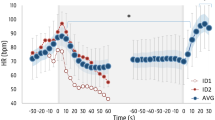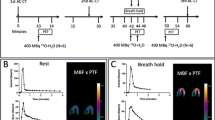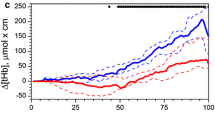Abstract
The incidence and nature of cardiac arrhythmias during static apnea were studied by monitoring the electrocardiogram (ECG) and oxygen saturation (SaO2) of 16 recreational breath-hold divers. All subjects completed a maximal apnea with a mean (±SD) breath-hold duration of 281 (±73) s without clinical complications. Both heart rate (HR) and SaO2 decreased significantly with breath-hold duration. The decline in SaO2 was inversely related to the decline in HR (r = −0.55, P < 0.05). Cardiac arrhythmias (supraventricular and ventricular premature complexes, right bundle branch block) occurred in 12/16 (77%) subjects and were related to breath-hold duration. Subjects with atrial premature complexes (n = 9) had a reduced BMI (P = 0.016) and a higher decline of the terminal SaO2 (P = 0.01). In conclusion, ectopic arrhythmias were common during maximal static apneas for training purposes. The results indicate that the occurrence of ectopic beats is associated with individual factors such as the tolerable SaO2 decrease.



Similar content being viewed by others
References
Bonneau A, Friemel F, Lapierre D (1989) Electrocardiographic aspects of skin diving. Eur J Appl Physiol 58:487–493. doi:10.1007/BF02330702
Butler PJ, Jones DR (1997) Physiology of diving of birds and mammals. Physiol Rev 77:837–899
Claessens P, Claessens C, Claessens M, Bloemen H, Verbanck M, Fagard R (1999) Ventricular premature beats in triathletes: still a physiological phenomenon? Cardiology 92:28–38. doi:10.1159/000006943
Dujic Z, Ivancev V, Heusser K, Dzamonja G, Palada I, Valic Z, Tank J, Obad A, Bakovic D, Diedrich A, Joyner MJ, Jordan J (2008) Central chemoreflex sensitivity and sympathetic neural outflow in elite breath-hold divers. J Appl Physiol 104:205–211. doi:10.1152/japplphysiol.00844.2007
Ferretti G (2001) Extreme human breath-hold diving. Eur J Appl Physiol 84:254–271. doi:10.1007/s004210000377
Ferrigno M, Grassi B, Ferretti G, Costa M, Marconi C, Cerretelli P, Lundgren C (1991) Electrocardiogram during deep breath-hold dives by elite divers. Undersea Biomed Res 18:81–91
Ferrigno M, Ferretti G, Ellis A, Warkander D, Costa M, Cerretelli P, Lundgren CEG (1997) Cardiovascular changes during deep breath-hold dives in a pressure chamber. J Appl Physiol 83:1282–1290
Gentile C, LaScala S (2001) Hemodynamic and respiratory changes in athletes during deep breath-hold diving. Minerva Anestesiol 67:875–880
Golbin JM, Somers VK, Caples SM (2008) Obstructive sleep apnea, cardiovascular disease, and pulmonary hypertension. Proc Am Thorac Soc 5:200–206. doi:10.1513/pats.200708-143MG
Grimm W, Hoffmann J, Menz V, Köhler U, Heitmann J, Peter JH, Maisch B (1996) Electrophysiologic evaluation of sinus node function and atrioventricular conduction in patients with prolonged ventricular asystole during obstructive sleep apnea. Am J Cardiol 77:1310–1314. doi:10.1016/S0002-9149(96)00197-X
Grimm W, Koehler U, Fus E, Hoffmann J, Menz V, Funck R, Peter JH, Maisch B (2000) Outcome of patients with sleep apnea-associated severe bradyarrhythmias after continuous positive airway pressure therapy. Am J Cardiol 86:688–692. doi:10.1016/S0002-9149(00)01055-9
Hong SK, Song SH, Kim PK, Suh CS (1967) Seasonal observations on the cardiac rhythm during diving in the Korean ama. J Appl Physiol 23:18–22
Lemaître F, Bernier F, Petit I, Renard N, Gardette B, Joulia F (2005) Heart rate responses during a breath-hold competition in well-trained divers. Int J Sports Med 26:409–413. doi:10.1055/s-2004-821159
Lin YC, Shida KK, Hong SK (1983) Effects of hypercapnia, hypoxia, and rebreathing on heart rate response during apnea. J Appl Physiol 54:166–171
Lin YC (1984) Circulatory functions during immersion and breath-hold dives in humans. Undersea Biomed Res 11:123–138
Lindholm P (2007) Loss of motor control and/or loss of consciousness during breath-hold competitions. Int J Sports Med 28:295–299. doi:10.1055/s-2006-924361
Lindholm P, Sundblad P, Linnarsson D (1999) Oxygen-conserving effects of apnea in exercising men. J Appl Physiol 87:2122–2127
Lindholm P, Blogg SL, Gennser M (2007) Pulse oximetry to detect hypoxemia during apnea: comparison of finger and ear probes. Aviat Space Environ Med 78:770–773
Morshedi-Meibodi A, Evans JC, Levy D, Larson MG, Vasan RS (2004) Clinical correlates and prognostic significance of exercise-induced ventricular premature beats in the community. Circulation 109:2417–2422. doi:10.1161/01.CIR.0000129762.41889.41
Mounsey JP, Ferguson JD (2003) The assessment and management of arrhythmias and syncope in the athlete. Clin Sports Med 22:67–79. doi:10.1016/S0278-5919(02)00064-9
Muth CM, Ehrmann U, Radermacher P (2005) Physiological and clinical aspects of apnea diving. Clin Chest Med 26:381–394. doi:10.1016/j.ccm.2005.05.007
Olsen CR, Fanestil DD, Scholander PF (1962) Some effects of breath holding and apneic diving on cardiac rhythm in ma. J Appl Physiol 17:461–466
Parkes MJ (2006) Breath-holding and its breakpoint. Exp Physiol 91:1–15. doi:10.1113/expphysiol.2005.031625
Perini R, Tironi A, Gheza A, Butti F, Moia C, Ferretti G (2008) Heart rate and blood pressure time courses during prolonged dry apnea in breath-hold divers. Eur J Appl Physiol 104:1–7. doi:10.1007/s00421-008-0771-1
Schagatay E, Andersson J (1998) Diving response and apneicv time in humans. Undersea Hyperb Med 25:13–19
Scholander PF, Hammel HT, LeMessurier H, Hemmingsen E, Garey W (1962) Circulatory adjustment in pearl divers. J Appl Physiol 17:184–190
Sharp D (2003) Faster, higher, stronger… and deeper? Lancet 362:846. doi:10.1016/S0140-6736(03)14349-8
Shaw DB (1982) Ventricular premature beats-stormy petrels? Br Med J (Clin Res Ed) 284:367–368
Stewart IB, Bulmer AC, Sharman JE, Ridgway L (2005) Arterial oxygen desaturation kinetics during apnea. Med Sci Sports Exerc 37:1871–1876. doi:10.1249/01.mss.0000176305.51360.7e
Zipes DP, Ackerman MJ, Estes NA 3rd, Grant AO, Myerburg RJ, Van Hare G (2005) Task force 7: arrhythmias. J Am Coll Cardiol 45:1354–1363
Tipton MJ, Kelleher PC, Golden FSC (1994) Supraventricular arrhythmias following breath-hold submersions in cold water. Undersea Hyperb Med 21:305–313
Xie A, Skatrud JB, Crabtree DC, Puleo DS, Goodman BM, Morgan BJ (2000) Neurocirculatory consequences of intermittent asphyxia in humans. J Appl Physiol 89:1333–1339
Yamaguchi H, Tanaka H, Obara S, Tanabe S, Utsuyama N, Takahashi A, Nekahira J, Yamamoto Y, Jiang ZL, He J (1993) Changes in cardiac rhythm in man during underwater submersion and swimming studied by ECG telemetry. Eur J Appl Physiol 66:43–48. doi:10.1007/BF00863398
Author information
Authors and Affiliations
Corresponding author
Rights and permissions
About this article
Cite this article
Hansel, J., Solleder, I., Gfroerer, W. et al. Hypoxia and cardiac arrhythmias in breath-hold divers during voluntary immersed breath-holds. Eur J Appl Physiol 105, 673–678 (2009). https://doi.org/10.1007/s00421-008-0945-x
Accepted:
Published:
Issue Date:
DOI: https://doi.org/10.1007/s00421-008-0945-x




